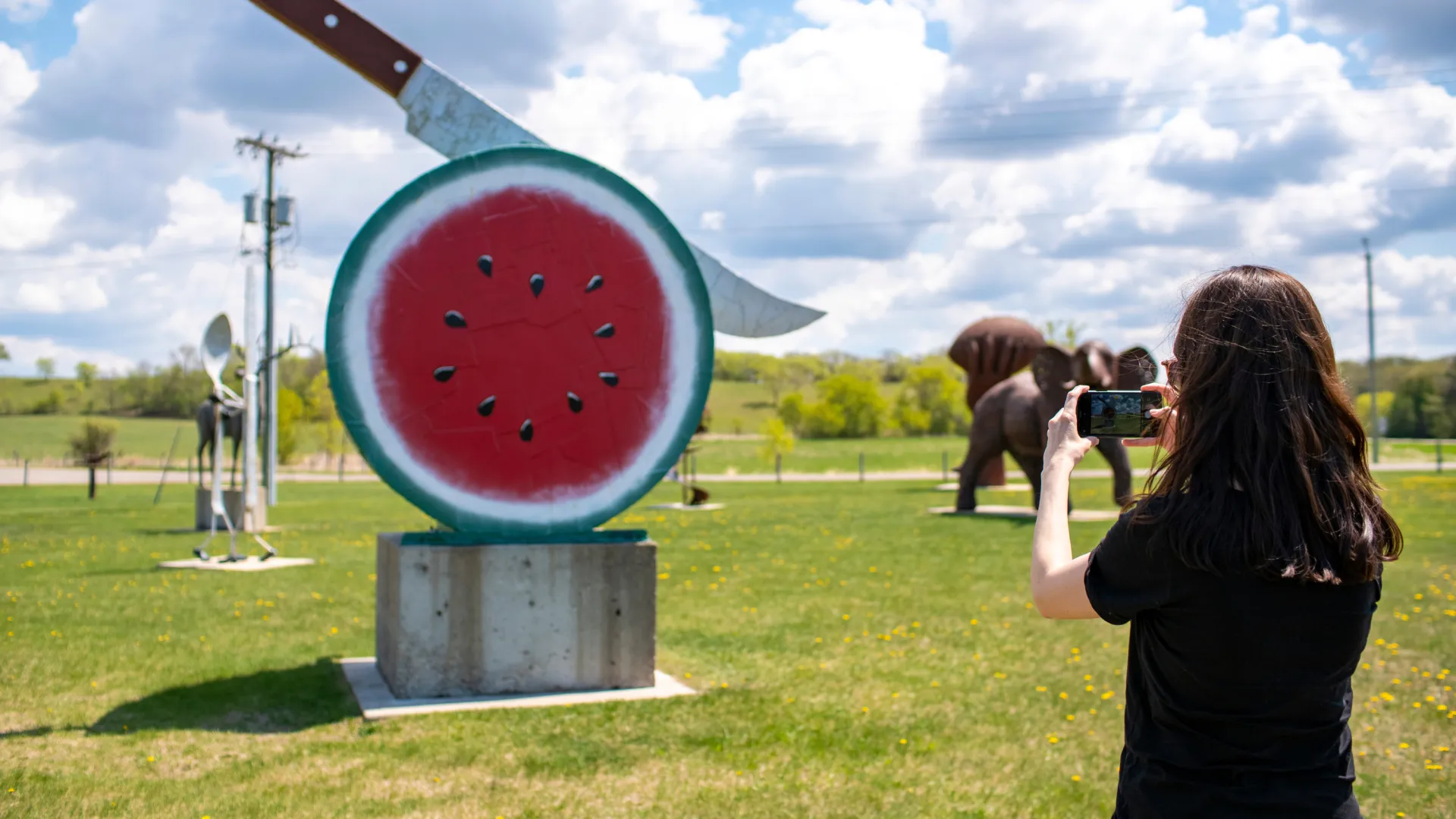
Minnesota's Best Public Art
Whether it’s publicly funded projects, instantly recognizable icons, or the thrilling work of local creators, Minnesota is home to a host of accessible public art. Here are some of the state’s best installations, murals, statues and sculpture parks, from the Iowa border to the Northwoods.
INSTALLATIONS
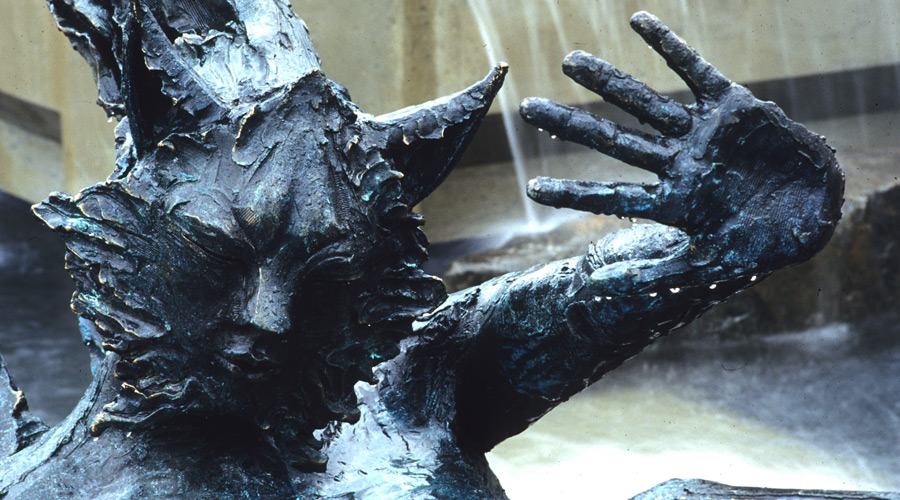
Fountain of the Wind
Duluth
Douglas Freeman’s “Fountain of the Wind” can be found in Duluth's Canal Park, right along the Lake Superior shoreline. A mythical wildcat — called “Wildcat Dreaming” — sits at the center of a fountain that includes water spouting from bronze lake trout, towers, and steppingstones that allow visitors to skip across the water as though they’re a mythical creature wandering through Freeman’s vision.
Freeman calls the wildcat a creature of the subconscious, with all the magic, fear, and mystery that implies. The entire creation is the result of local legends, Ojibwa traditions, and the region’s natural beauty.
Hot Sam's Antiques
Lakeville
How to explain Hot Sam’s? According to co-owner Bobbie “Jake” Hood, it’s not only an antique shop, junkyard and folk-art installation, but a full-on “foto park.” At this secluded gem, you might spy a fiberglass dinosaur or train car peeking out through the scrub as you pass on the highway.
What’s inside is wild. It’s packed with repurposed trucks, train cars, and carnival rides, all transformed into a singular experience that consistently has visitors snapping photo after photo. Much of the work encourages videos to climb inside and explore, whether it’s swings or a Jurassic Park jeep.
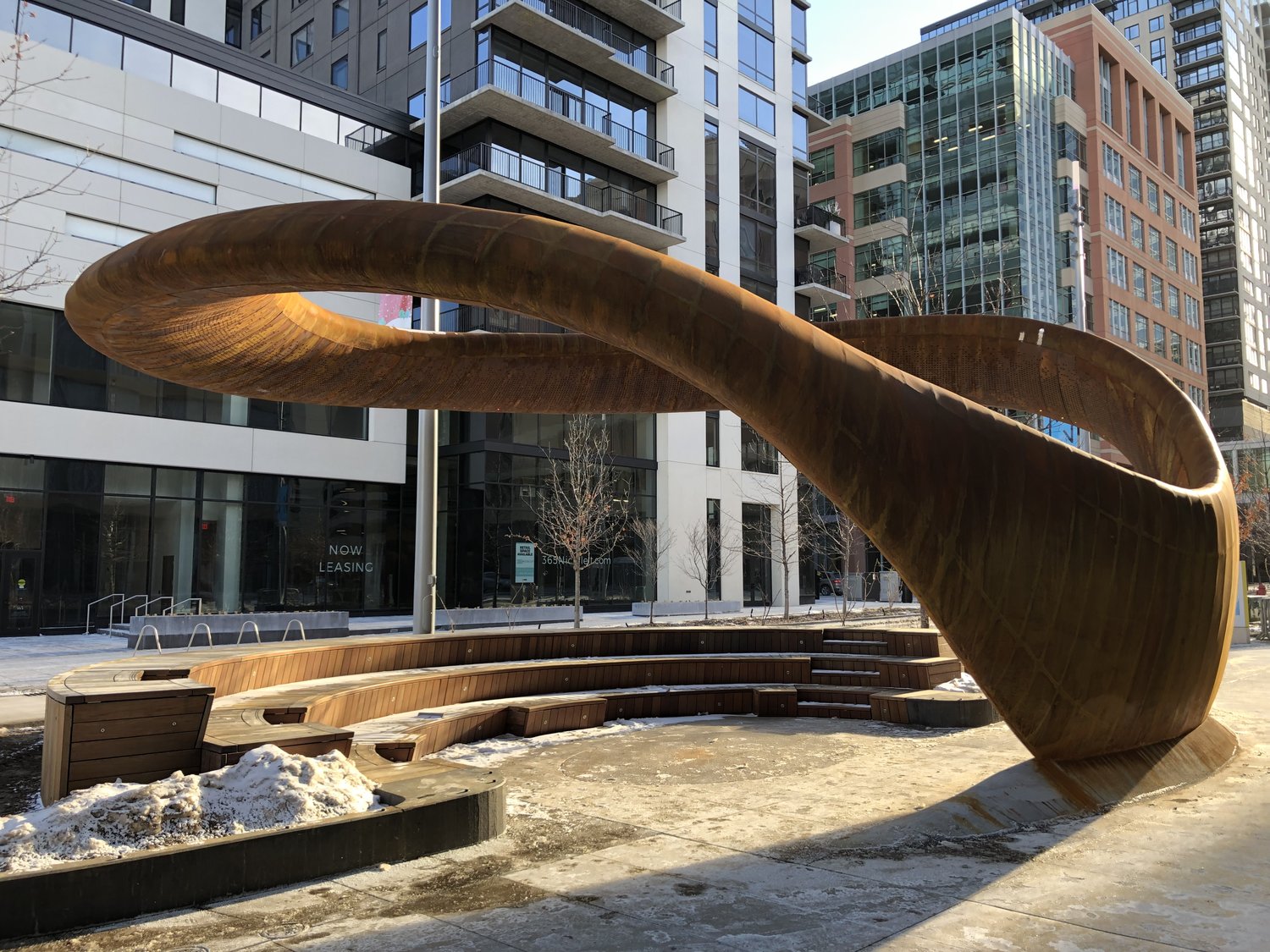
Nicollet Mall
Minneapolis
Downtown Minneapolis' prime Nicollet Mall stretch isn’t just a hub for shopping and the Minnesota Orchestra. It’s rife with art. Walk the street to find artist-designed manhole covers, Kinji Akagawa’s “Enjoyment of Nature” installation, and instantly recognizable pieces like the “Sculpture Clock” and Stanton Sears’ “Ston Boats.”
While towering pieces like “Great Blue Heron, Loon and Sage Grouse Fountain” and the 10-ton “Nimbus” are eye-catching, don’t ignore the art you’ll walk over, like the seven shadows set into the sidewalk honoring Minnesota changemakers, each adorned with poems by Soyini Guyton.
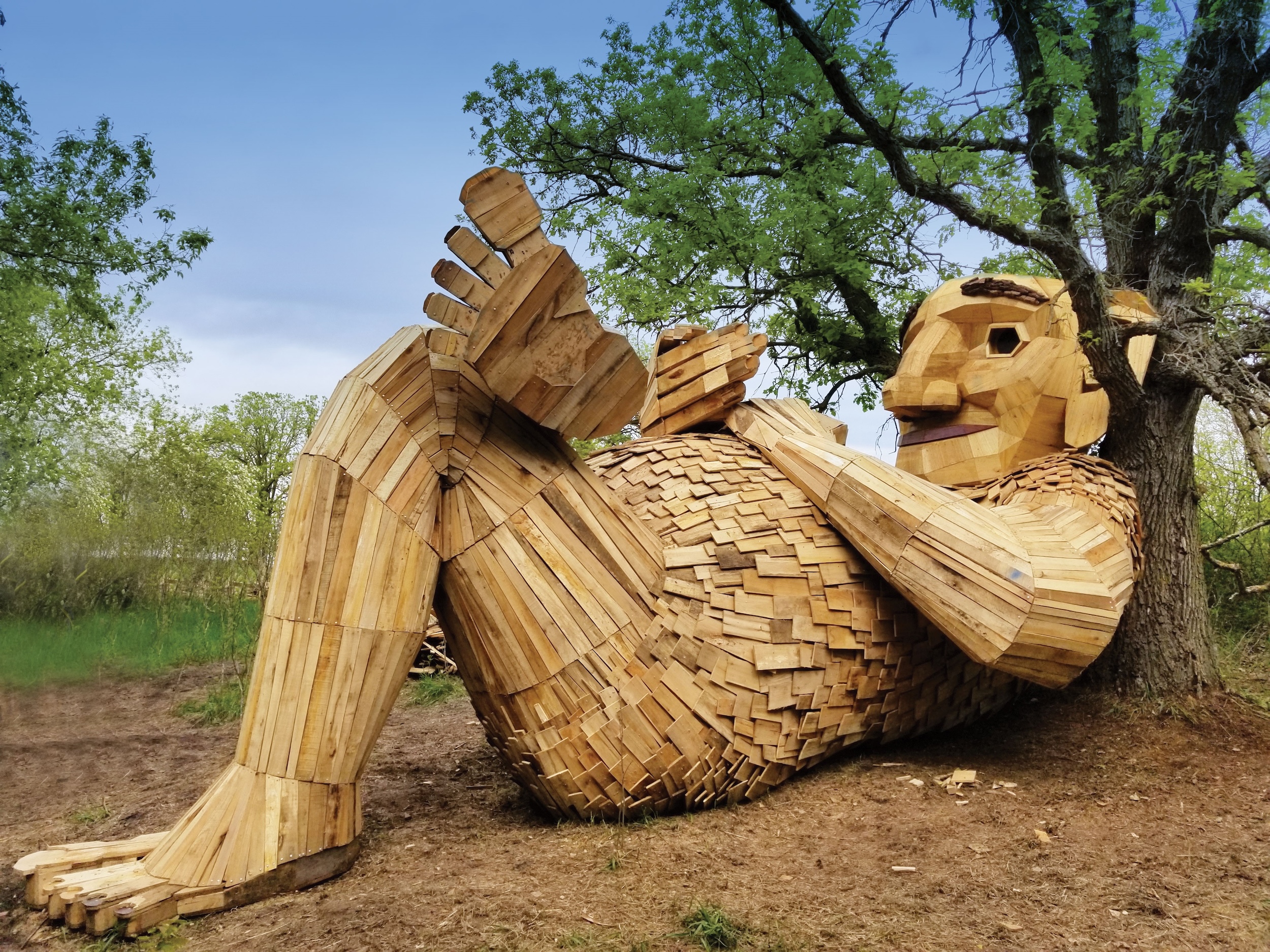
Thomas Dambo's Trolls
Detroit Lakes
Danish artist Thomas Drambo has installed towering trolls made of recycled wood and other repurposed materials across the globe. His largest high concept project to date recently found a home in Detroit Lakes.
The installation is scattered around the region in a sort of scavenger hunt where its six trolls, giant rabbit, and three portals can only be found by following the clues from Alexa’s Elixir, a spell book that acts as a guide to the art-centric quest. You’ll want to set aside a little time to find to them, as some require a bit of a hike to track down.

Union Depot
St. Paul
Since its 2012 transformation, St. Paul’s main train station has become more than a travel hub. In 2024, it filled its open spaces and storefronts with additions like the 1881 Eatery House restaurant, Choo Choo Bob’s Train Store, and Story Line Books. Beyond events like the St. Paul Art Crawl and Twin Cities Book Festival, Union Depot is home to 10 pieces of public art.
Among them are six works on the complex cultural history of America by figurative muralist Ralph Gilbert and the earthy “Trainscape” by Minnesota artists Amy Baur and Brian Bolton. There are also more unexpected pieces like “Twin Waves,” a light sculpture by Ray King that dangles glass, metal, and other materials from the Depot’s ceiling. Tim Prentice’s “Side Track” was the first installation after the Depot’s redesign. Its enticing structure evokes trains and progress with wire and metal running through the air near the Depot’s Kellogg entry.
MONUMENTS
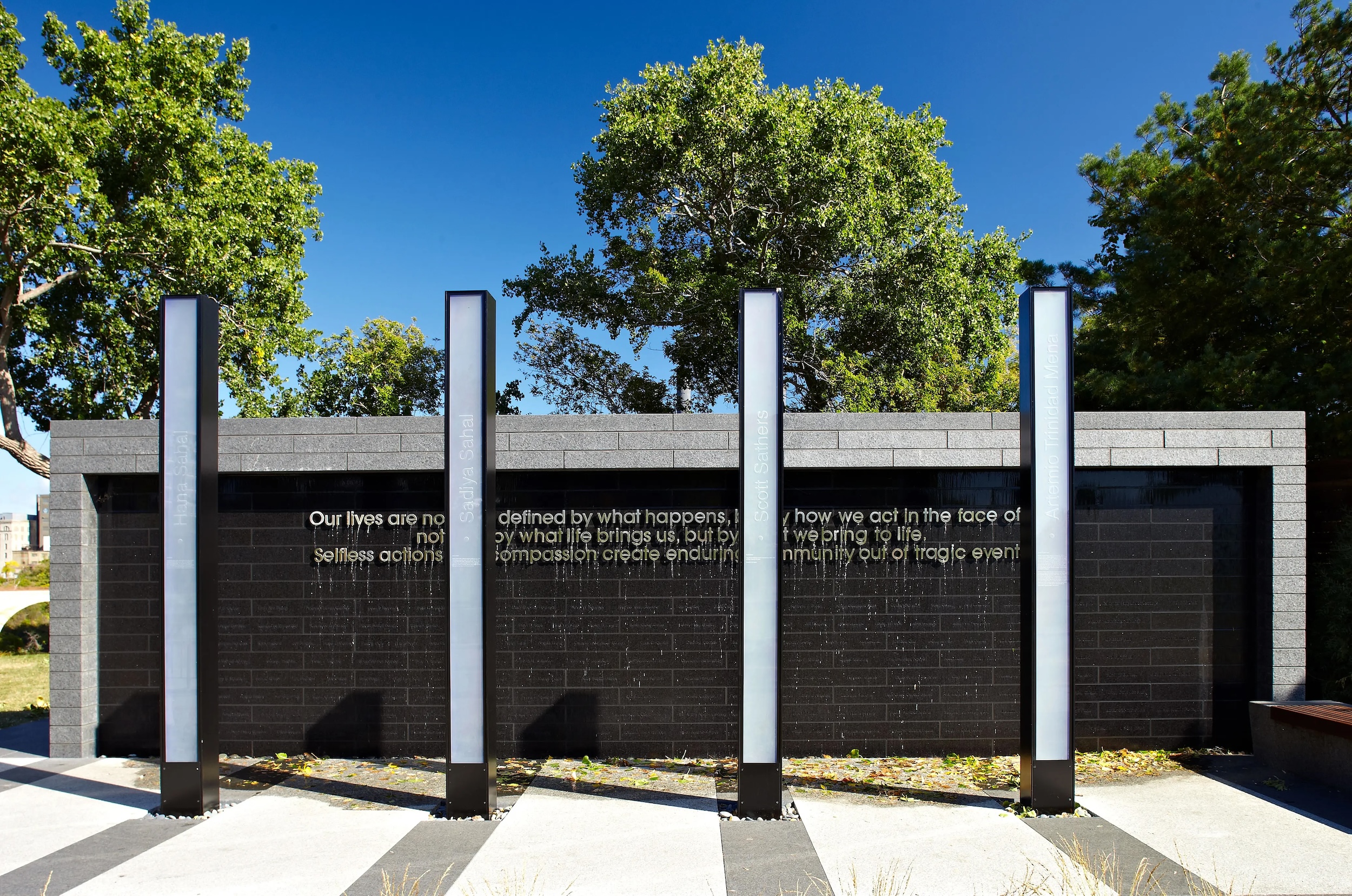
35W Bridge Remembrance Garden
Minneapolis
The 35W Bridge in Minneapolis collapsed in 2007, killing 13 and injuring 145. The tragedy is commemorated with an 81-foot granite wall (a nod to the date of the accident, Aug. 1) bearing the names of everyone hurt in the incident. In front of the wall are 13 I-beams, one for each of the victims who died.
It’s a touching place for reflection that evokes the area’s beauty. At night, the I-beams light up, evoking the way the bridge is often lit up in the evening as people scurry between Downtown and Northeast Minneapolis.
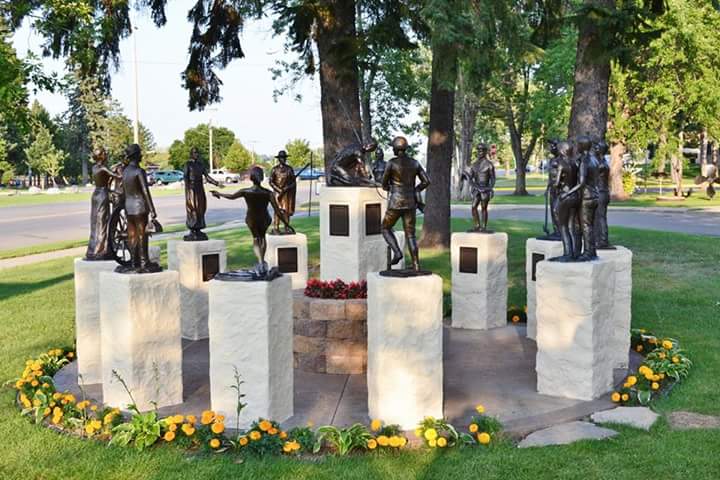
Circle of Time
Walker
Just outside the Cass County Museum sits a cycle of 13 bronze statues arranged in a ring that invites visitors to experience the cultural history of the Leech Lake region.
A dozen figures are arranged around the circle with a 13th, an early man cleaning the hide of a wooly mammoth, placed in the center. Around this hunter are depictions of groups that have called the region home, including an Ojibwe woman toting a baby, a fur trapper holding a pelt, a missionary, a homesteader, a sunglasses-clad fisherman, and a contemporary family of four.

Czech Immigrant Memorial
St. Paul
This sculpture is a symbolic gate, welcoming and honoring the Czech and Slovak immigrants who have been a part of the fabric of St. Paul since the 1860s. Often covered in vines, it’s comprised of salvaged materials, including a baptismal gate from the Church of St. Stanislaus and pavers from city streets.
The church was founded by Czech immigrants in 1872, who, before its founding, had worshipped in German churches where they didn’t know the language. Visitors will also spot a water nymph, a representation of the titular character from Czech composer Antonin Dvorak’s “Rusalka” opera.
Created by University of Minnesota graduate Craig David in 1976, it’s a place that honors St. Paul’s rich multicultural history with a symbolic door to a new life and new communities.
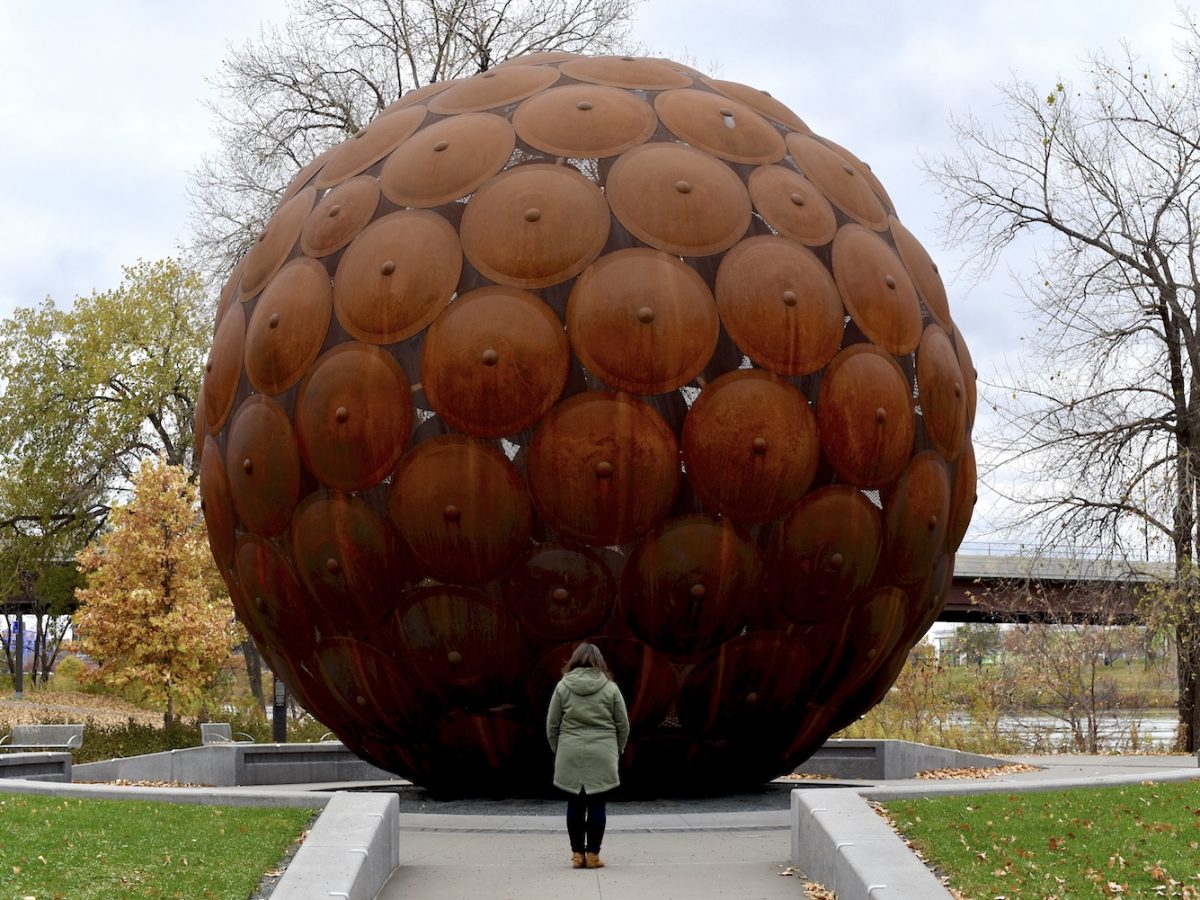
Ethos
Minneapolis
“Ethos,” a 35-foot geodesic polyhedron by the Minneapolis artist Robert Smart, sits along the Mississippi River in northeast Minneapolis. Dedicated in 2014, the sculpture is the result of two decades of work from a group of WWII veterans who wanted to honor Minnesota’s veterans.
The orb is made of interconnected steel shields, symbolizing peace and protection, surrounded by 11 granite markers, 10 of which represent armed conflicts where 16,217 Minnesotans and 50 Dakota warriors were killed. The 11th marker features a child, a symbol of the future and the need to dedicate ourselves to peace.
It’s an emphatically contemplative space that draws viewers to silence, amplified by interior lighting that makes it seem as if “Ethos” is alive in the evening.
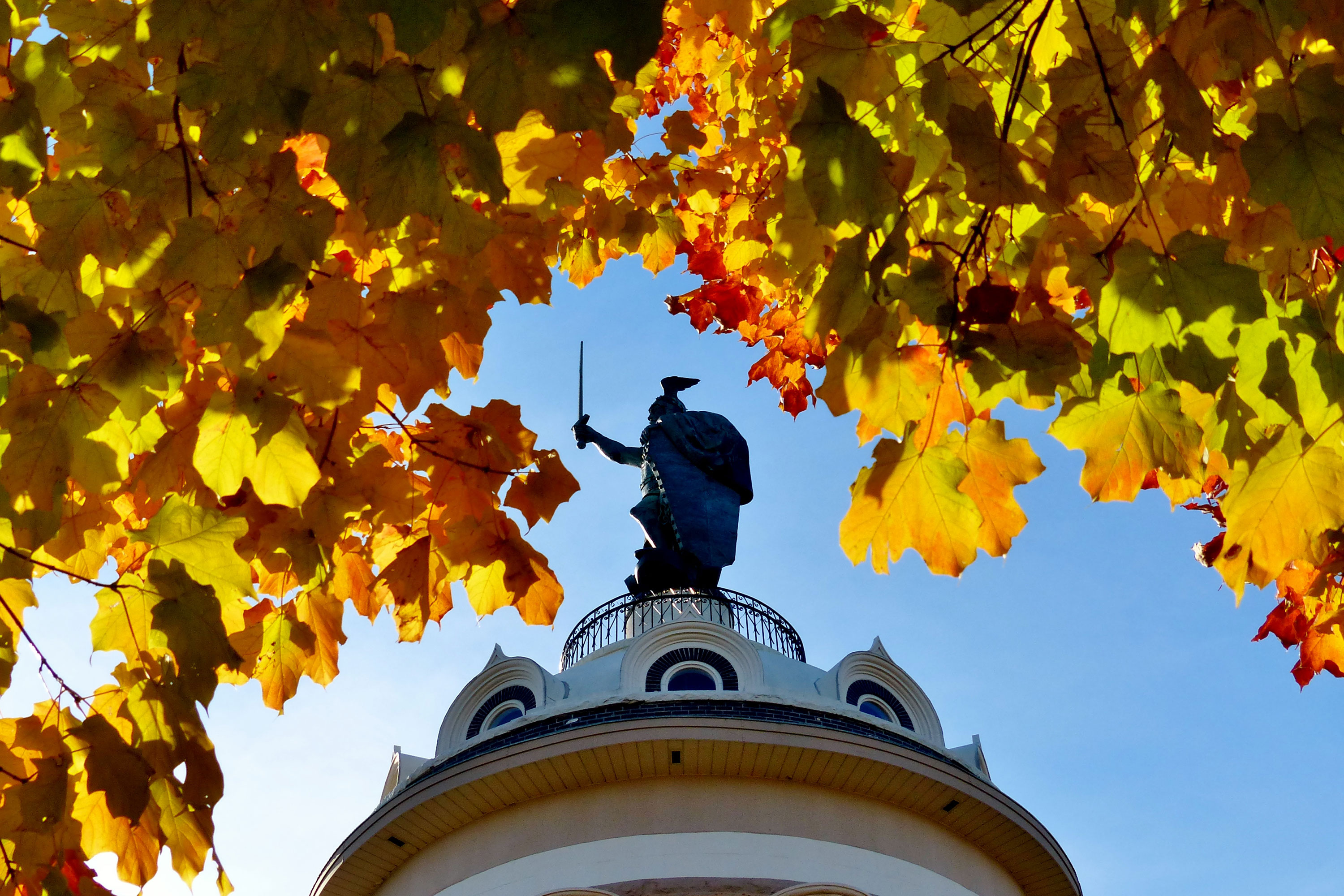
Hermann the German
New Ulm
New Ulm isn’t just home to one of the state’s biggest Oktoberfest celebrations. The town’s Germanic roots run deep in a 102-foot monument of Hermann the Cheruscan, the first-century hero who repelled the Romans from Germany. When German immigrants came to the U.S., their reverence for Hermann followed. So, it makes sense that the city dubbed “the most German town in America” is home to a towering statue of Hermann, which was commissioned by the Order of Hermann’s Sons — a New York-based organization — in 1887.
The building atop which it is positioned isn’t always open, but at such a great height, Hermann is visible anytime. However, if you’re there when the site is open, the staircase leads to a sweeping view of New Ulm from the top of Hermann Heights Park.
MURALS
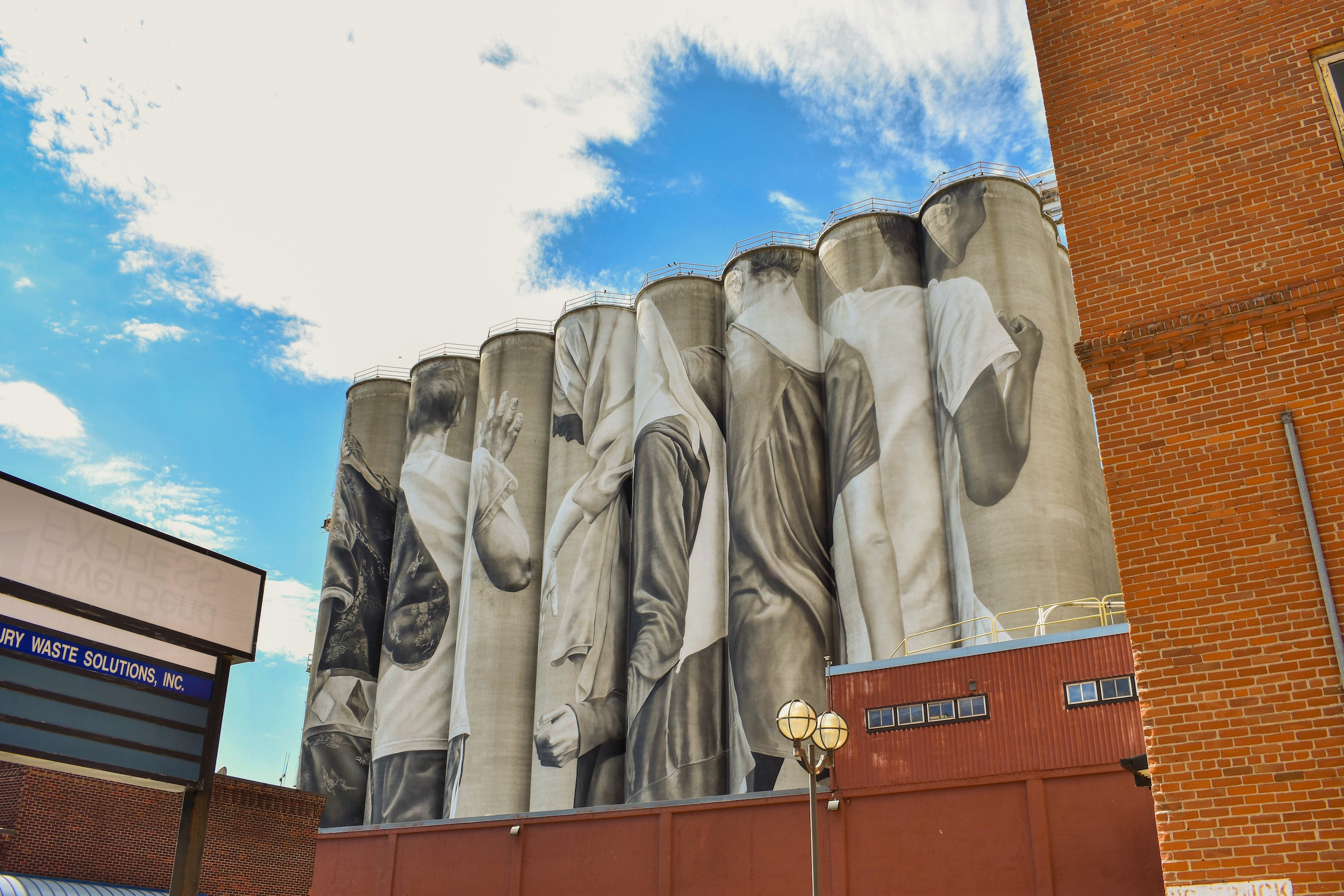
Ardent Mills
Mankato
Mankato is home to a stunning, can’t-miss mural. (As in, it’s gorgeous and it’s literally hard to miss.) Commissioned by CityArt and created by Guido van Helten, the 135-foot-tall mural stretches across eight grain silos at the former home of Ardent Mills in Mankato. It pays homage to the region’s diversity and is based on photos taken at a Mahkato Pow Wow event.
It’s an iconic piece of art in Mankato. However, Ardent Mills closed its plant in 2024, leaving the future of the mural up in the air. The company says it’s been working with the city to ensure the art is preserved.
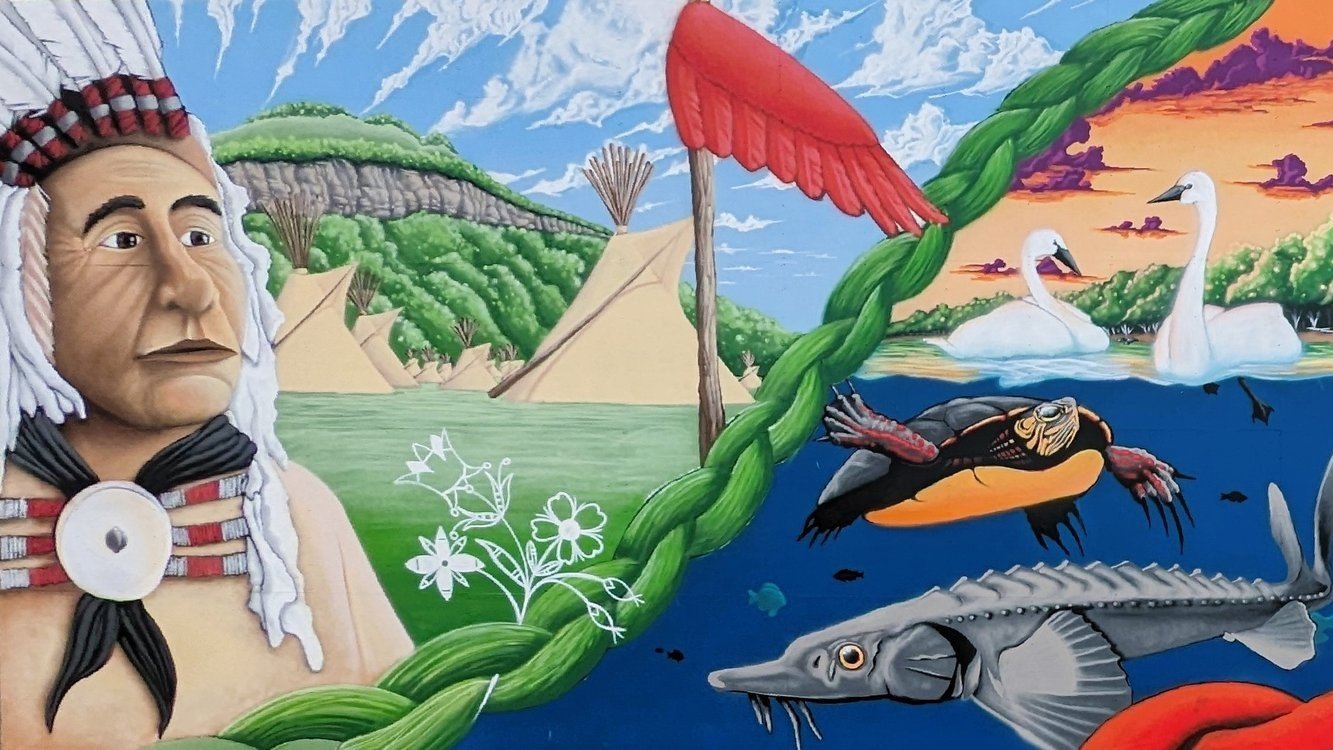
The Honoring Dakota Project
Red Wing
The Honoring Dakota Project mural was created by artists Collins Provost-Fields, Jeremy Fields and Cole Redhorse Taylor. It’s situated near the He Mni Can-Barn Bluff, and a recognition of the Dakota land and people, as Red Wing sits on the traditional homeland of the Dakhóta Oyáte. It portrays the region and its inhabitants before colonization in three sections divided by a sweetgrass braid.
According to the project’s organizers, the impactful mural has been a hub of community conversations and education, as well as healing and reconciliation for both the Dakota community and non-Indigenous community. While in the area, take a little time to check out the Red Wing Mural at West 3rd & Plum Streets or the West End Mural at 1523 Old West Main Street.
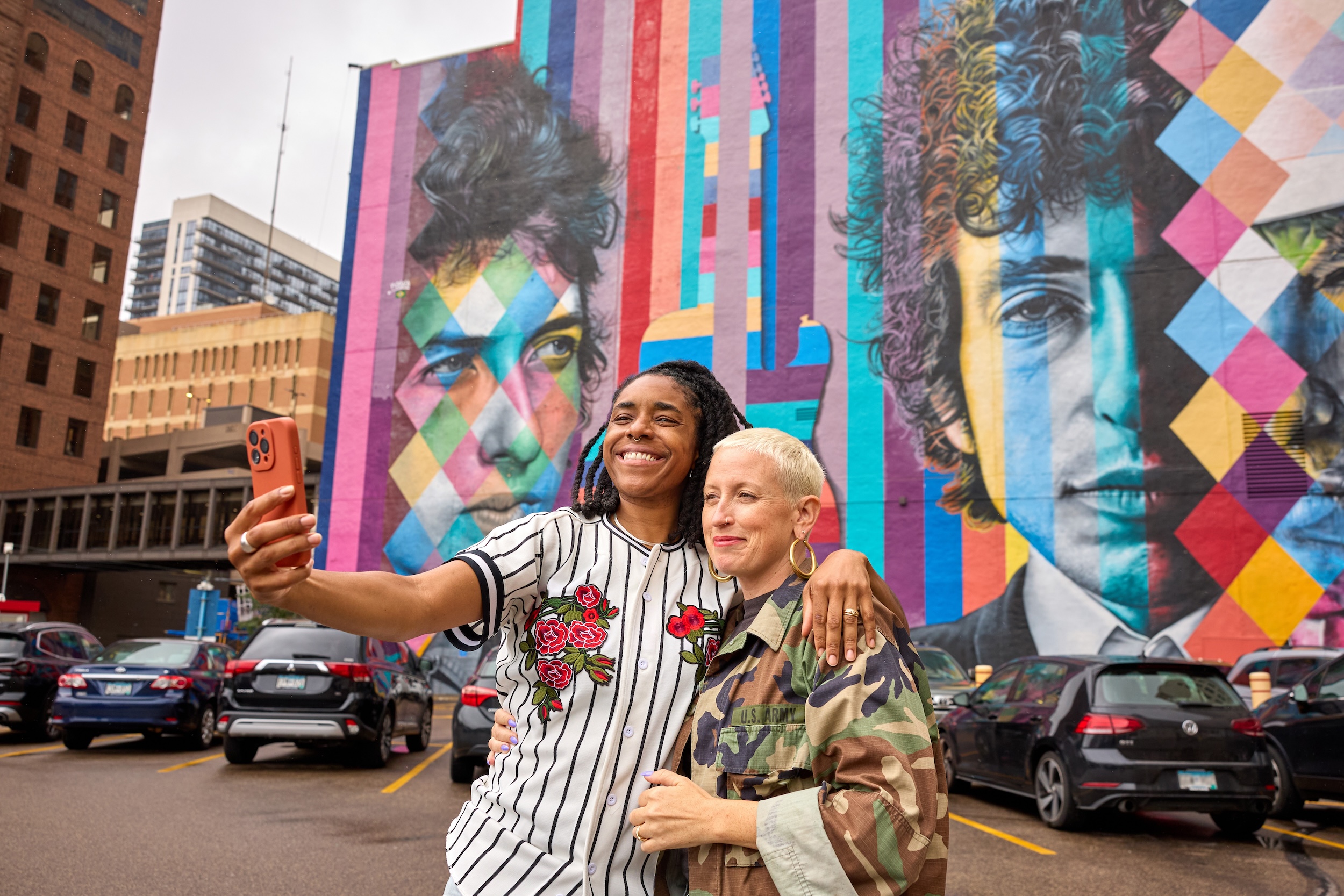
The Times They Are A-Changin'
Minneapolis
Brazilian artist Eduardo Kobra’s five-story Bob Dylan mural is a massive landmark in Downtown Minneapolis. In bright, bold colors, the mural’s three faces of Dylan are enmeshed in stripes and diamonds. It’s stunning in scope and vivacity, evoking the sort of crystal-clear reality and surrealism that could be used to describe the Minnesota-born musician himself. It’s also a great spot for a picture that tells a story on its own.
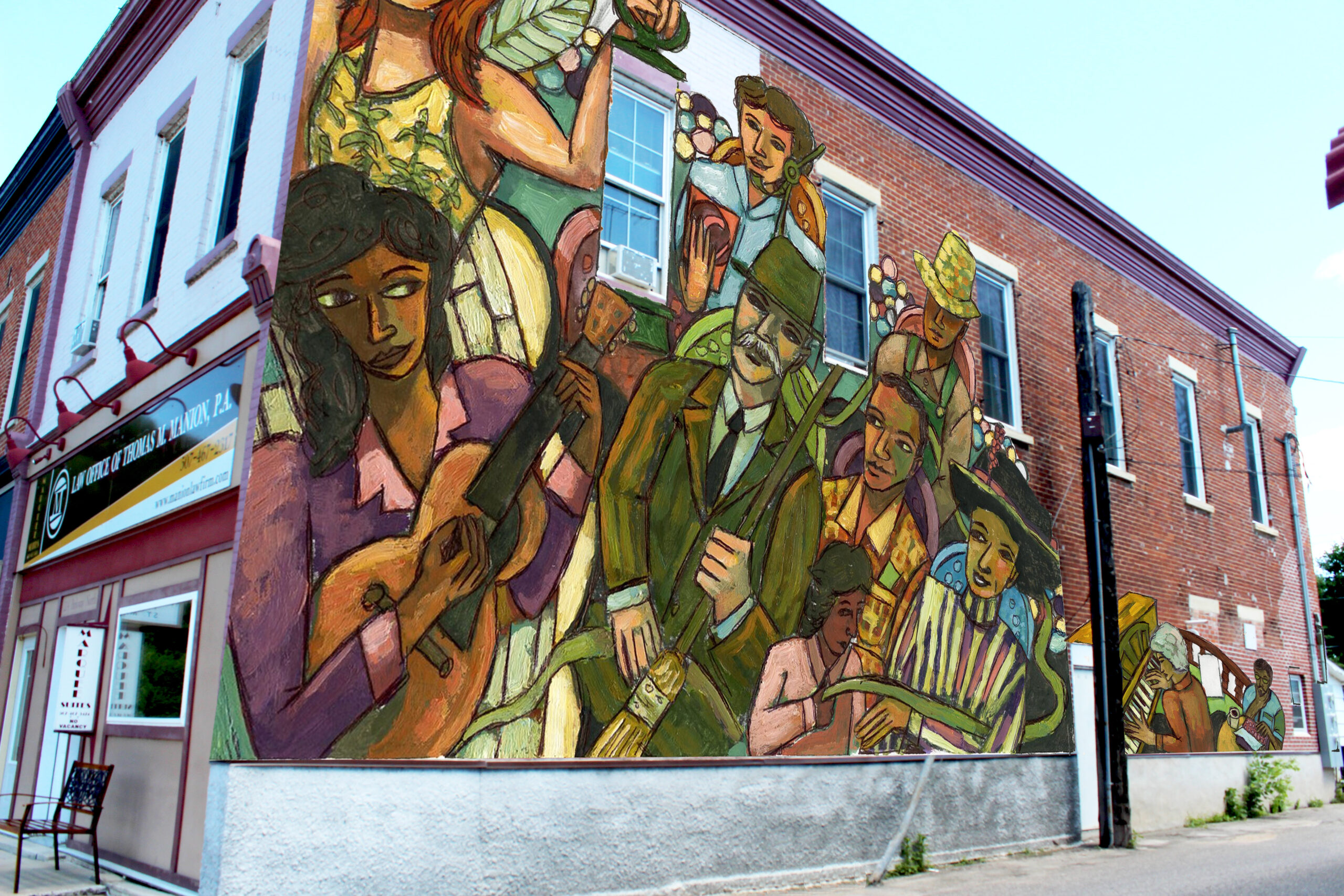
Various Locations
Lanesboro
Lanesboro houses a stunningly vibrant arts community for a city with a population under 1,000. The Theatre District mural, a 2023 work by Erik Pearson, celebrates the region’s diversity with a broad display near the city’s two main street theaters.
Over on the St. Mane Theatre, catch “Colors of Bluff Country.” It was created by area students in collaboration with Lanesboro Arts through the Surprise Sculpture program. Another mural, “Libraries Grow Community,” can be found on the city’s library. It features activities that define the region — tubing, biking, fishing — in a work led by Luisa Luis-Grill.
There are even more murals in town, as well as galleries like Lanesboro Arts, Semva Art Gallery, and the Pump House Regional Arts Center.
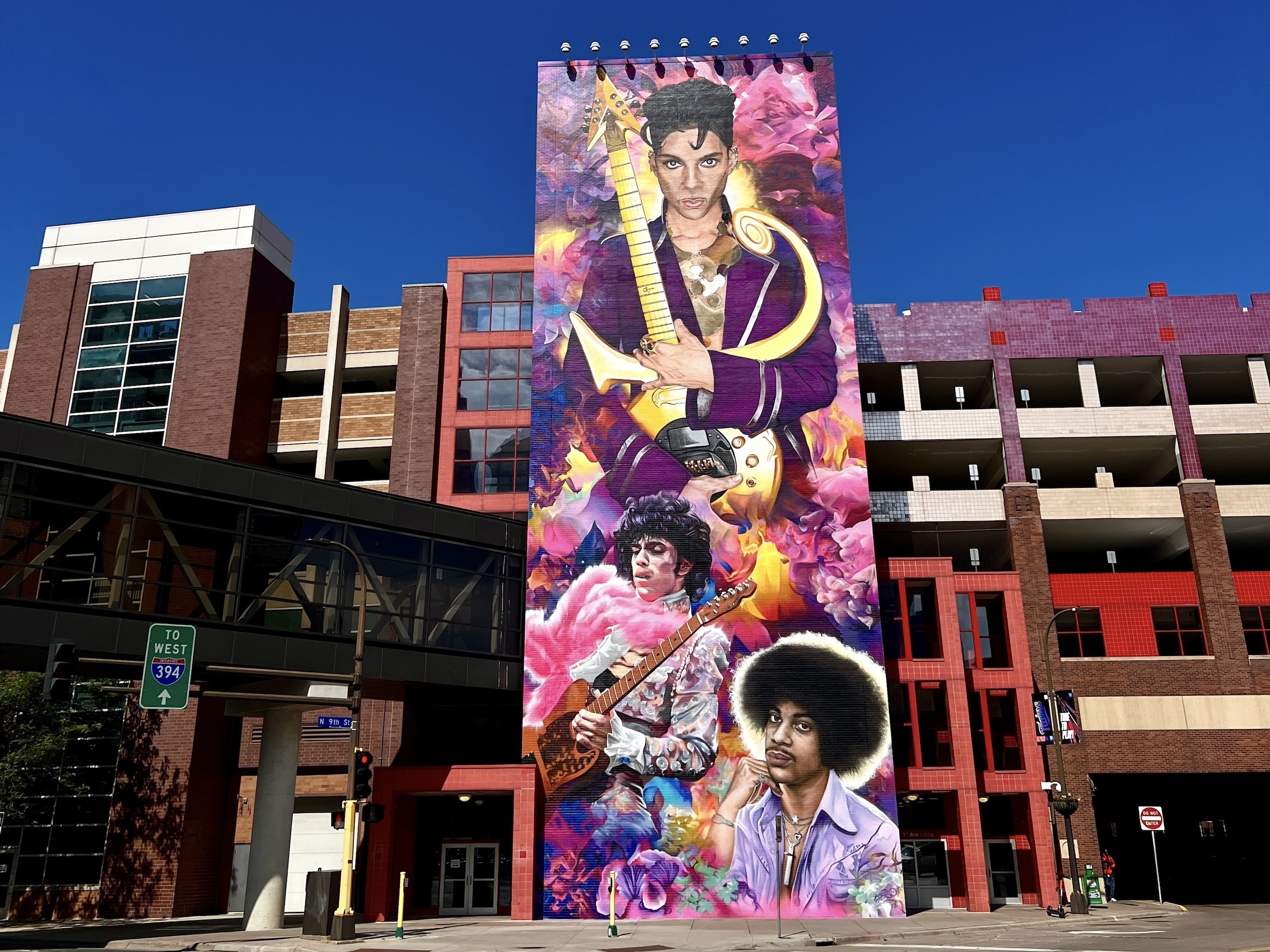
Various Prince Murals
Minneapolis
It’s a two-horse race for the title of the most iconic Minnesota musician. There’s Bob Dylan, and there’s Prince. The High Priest of Pop is honored all over the state. That includes a pair of murals in Downtown Minneapolis. The largest is a 100-foot-tall mural by Hiero Veiga, an artist handpicked by the Prince estate. The unmissable piece, unveiled in 2022, features three images of the purple legend overlooking an area of downtown where he frequently performed.
A crisper, more sparse mural, which is still two stories tall, sits in the North Loop. The work, created by artist Jonas Never, adorns the side of the 424 building on Washington Avenue.
Another smaller mural featuring Prince accompanied by doves can be found in Uptown at the corner of 26th Street and Hennepin Avenue.
SCULPTURE PARKS
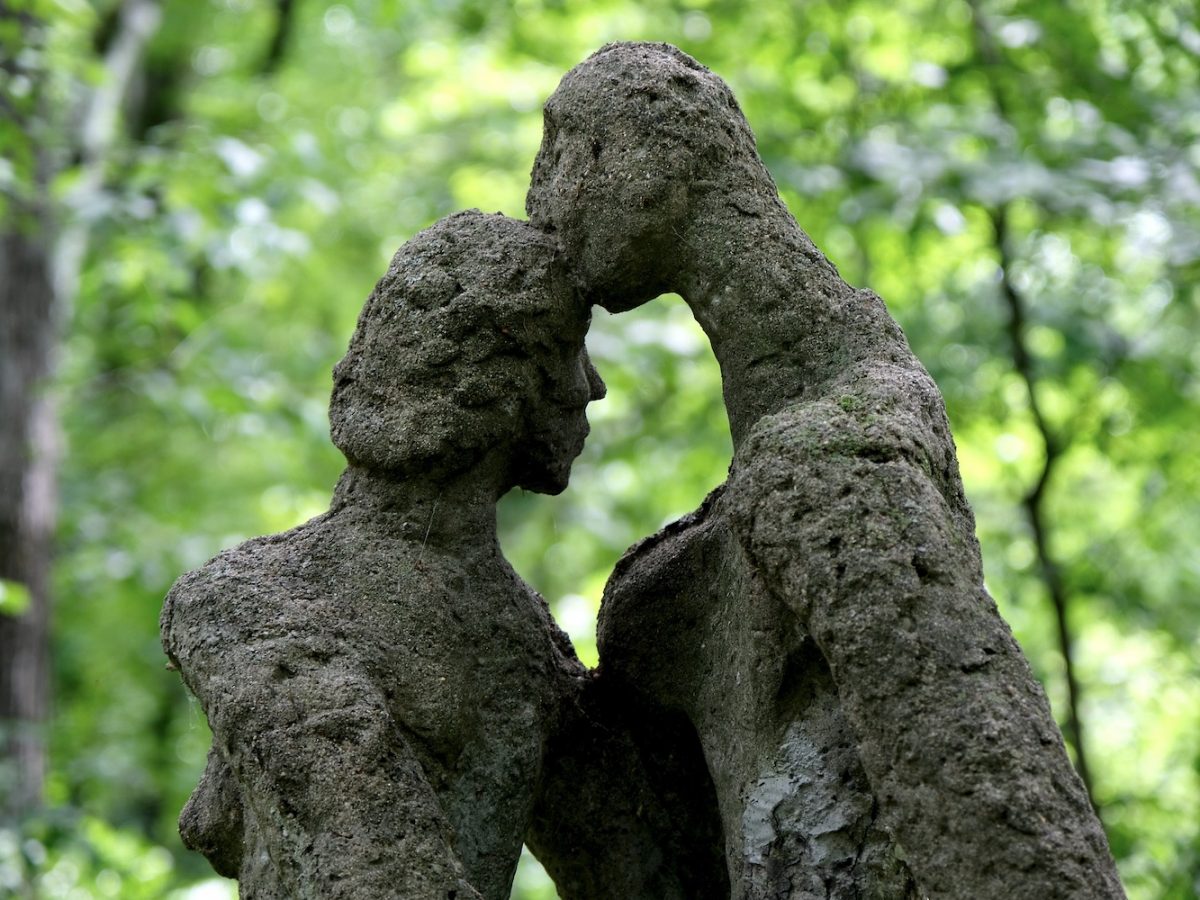
Caponi Art Park
Eagan
Anthony Caponi — a sculptor and professor at Macalester College in St. Paul — opened his art park to the public in 1987. It became a nonprofit community arts hub five years later.
Caponi Art Park not only features beautiful sculptural work but also hosts theatrical and musical events, as well as art happenings throughout the year’s warmer months. In total, the park houses more than 50 sculptures, including a treasure trove of cast iron work. It’s also home to an augmented reality art walk created by Spirit Lake Dakota artist Marlena Myles.
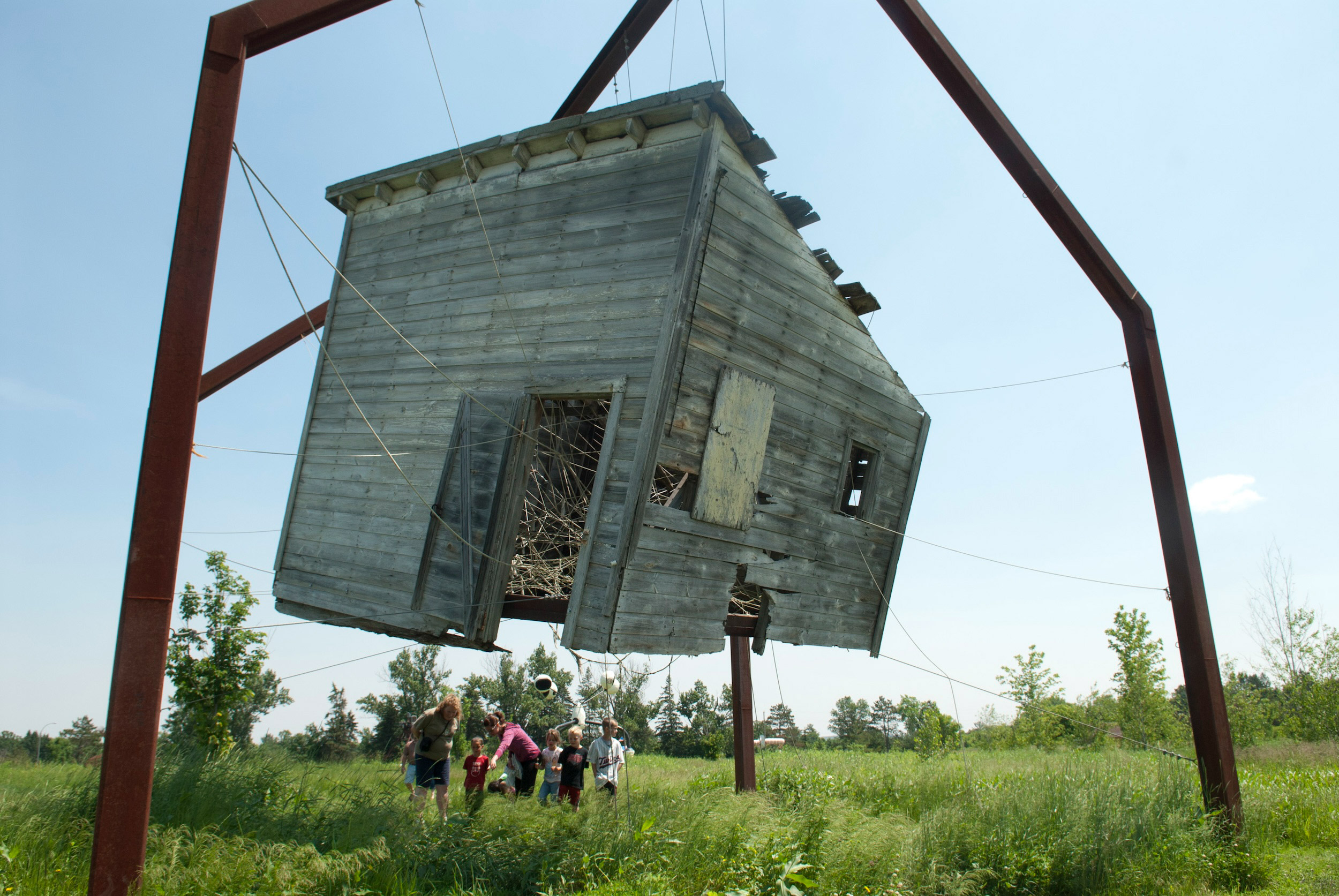
Franconia Sculpture Park
Shafer
Franconia Sculpture Park is a sprawling marvel tucked along Minnesota’s eastern border. It’s a 50-acre park with challenging and fun contemporary sculpture. There’s a playfulness at Franconia that entices visitors but never diminishes the incredible work being presented.
Many of the sculptures are built from reused and repurposed objects, such as a tower of boomboxes and a jungle gym built of reclaimed metal. It’s inviting, in part, because many of the sculptures invite participation. Visitors can climb inside some of the buildings, clamber across monkey bars, or shoot hoops at a hidden court in the field.
That’s without even mentioning the indoor art gallery, its movie nights, concerts, seasonal farmers market, and other activities that make Franconia an essential landmark for art lovers.

Nyberg Sculpture Park
Vining
Ken Nyberg began sculpting a gigantic foot in 1989. It was his entry into a world of enormous sculptures, and it ultimately led to the creation of the Nyberg Sculpture Park in a town with a population under 100.
Now, next to Big Foot Gas and Grocery, Nyberg’s many works have become a sculpture park filled with a dancing knife and spoon, pliers holding a cockroach, and a floating cup of coffee pouring its contents into the ground, as well as a sculpture of his daughter Karen, a NASA astronaut who has flown multiple missions to the International Space Station.
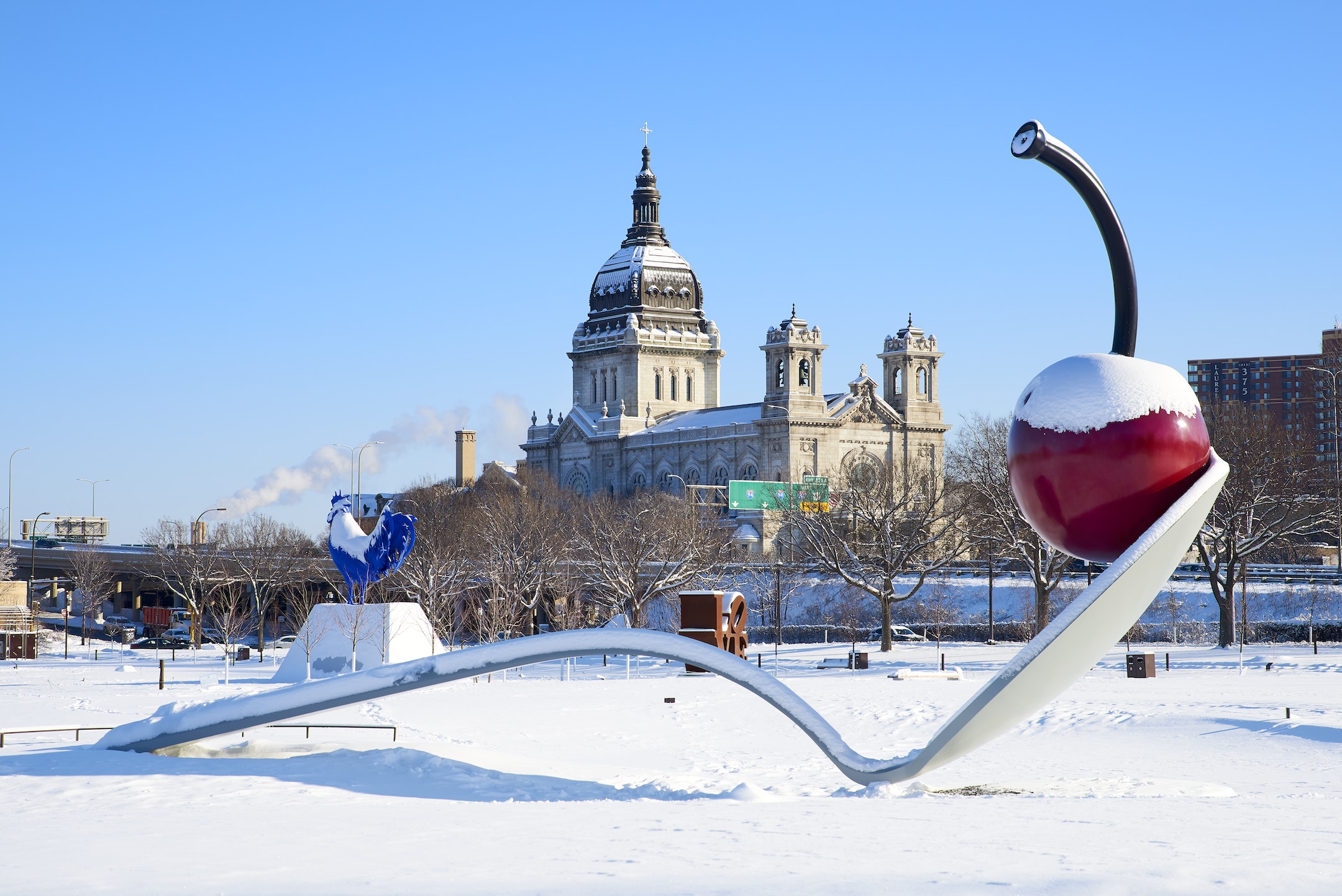
Walker Art Center
Minneapolis
When Minnesotans think of sculpture gardens, the Minneapolis Sculpture Garden and its iconic “Spoonbridge and Cherry” are likely to be top of mind. The Walker Art Center’s garden is large, airy, and has a great view of the Minneapolis skyline accompanying its more than 60 sculptures that span generations and movements.
Don’t miss Theaster Gates’ “Black Vessel for a Saint,” which allows visitors to walk inside, or the vibrant blue chicken, “Hahn/Cock” by Katharina Fritsch.

Western Sculpture Park
St. Paul
More than 15 sculptures dot the winding paths of Western Sculpture Park in St. Paul. It’s largely populated by work from Minnesotan artists. It’s more compact than a park like Franconia, and airier than others, making it a peaceful place to enjoy art and green space in the Twin Cities.
The largest piece is the imposing “Grace á Toi” by Mark di Suvero, known for his hulking steel I-beam sculptural work. More of di Suvero’s work can be found throughout the Twin Cities, including “Arikidea” in the Minneapolis Sculpture Garden and “Molecule” in Gold Medal Park.
STATUES
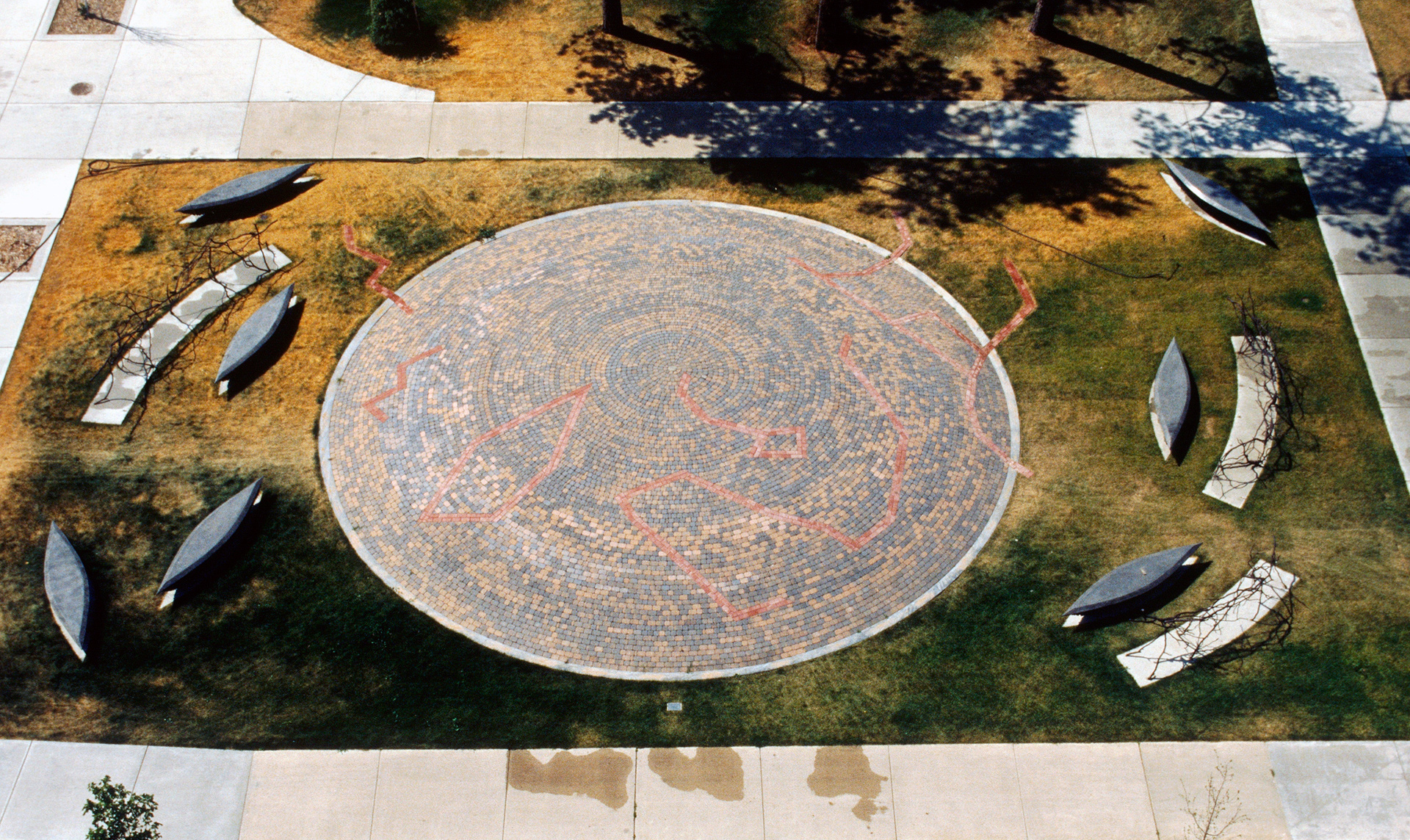
Crosswater
Bemidji
Sculptor Janet Lofquist has a few pieces around Minnesota, including one on the Bemidji State University campus. At its center is a dome adorned with star drawings. It’s surrounded by boat benches and cast bronze branches, evoking the beauty and history of Minnesota’s northern landscapes. The branches are inscribed with journal writings of Joseph Nicollet from his exploration of the Mississippi headwaters.
In addition to Lofquist’s work, Bemidji has dozens of sculptures as part of a sculpture walk around downtown. Another standout piece from the Glenwood native is “Habitat,” a foreboding boat with rib-like metal spires off County Highway 6 in Worthington.
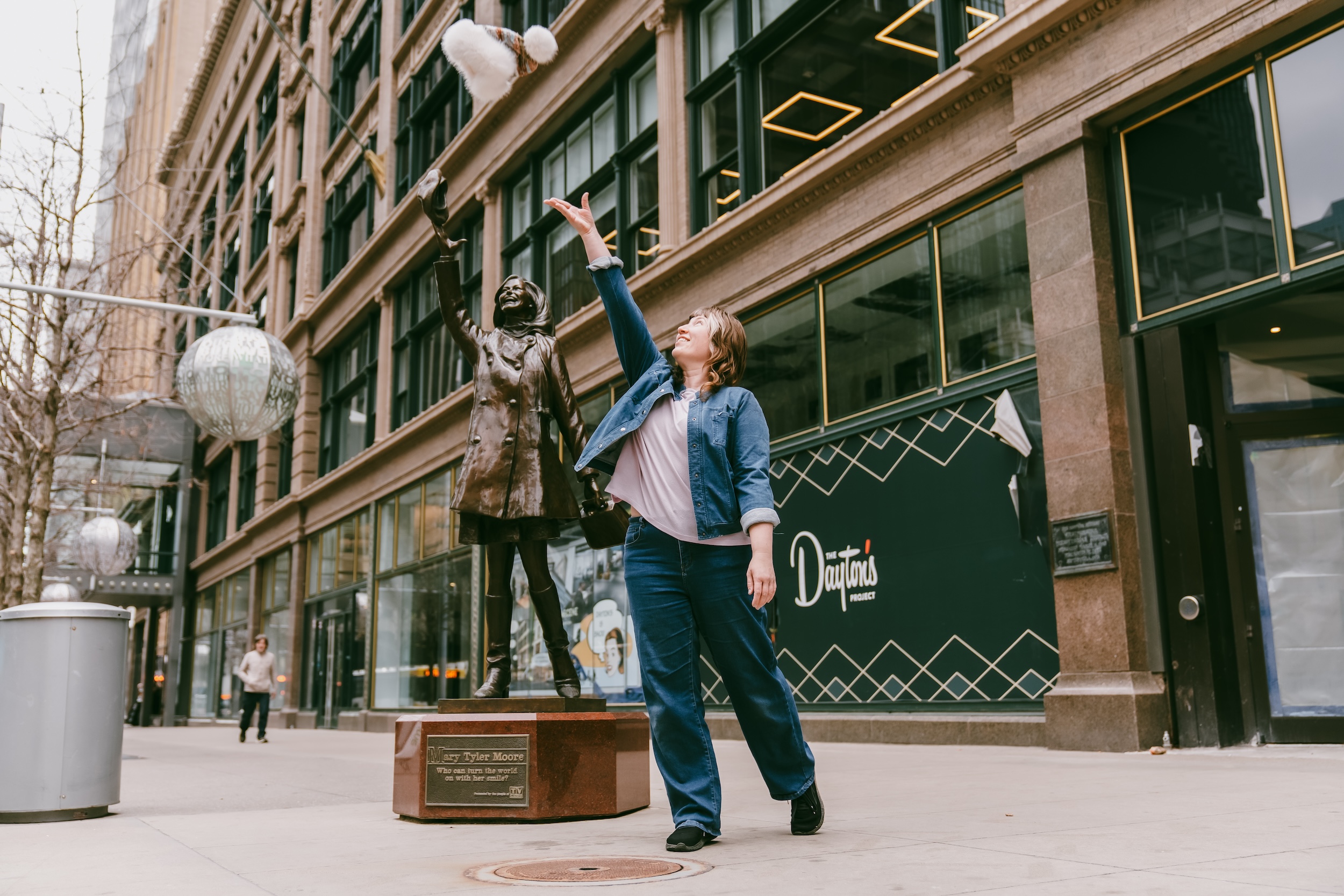
Mary Tyler Moore
Minneapolis
Mary Tyler Moore may be Minneapolis’ most famous fictional resident. A statue along Nicollet Mall captures the memorable moment when the late comedic actress would throw her hat in the air during the opening credits of “The Mary Tyler Moore Show.”
Visitors can frequently be seen grabbing snapshots next to Moore’s statue, mimicking her hat-throwing pose.
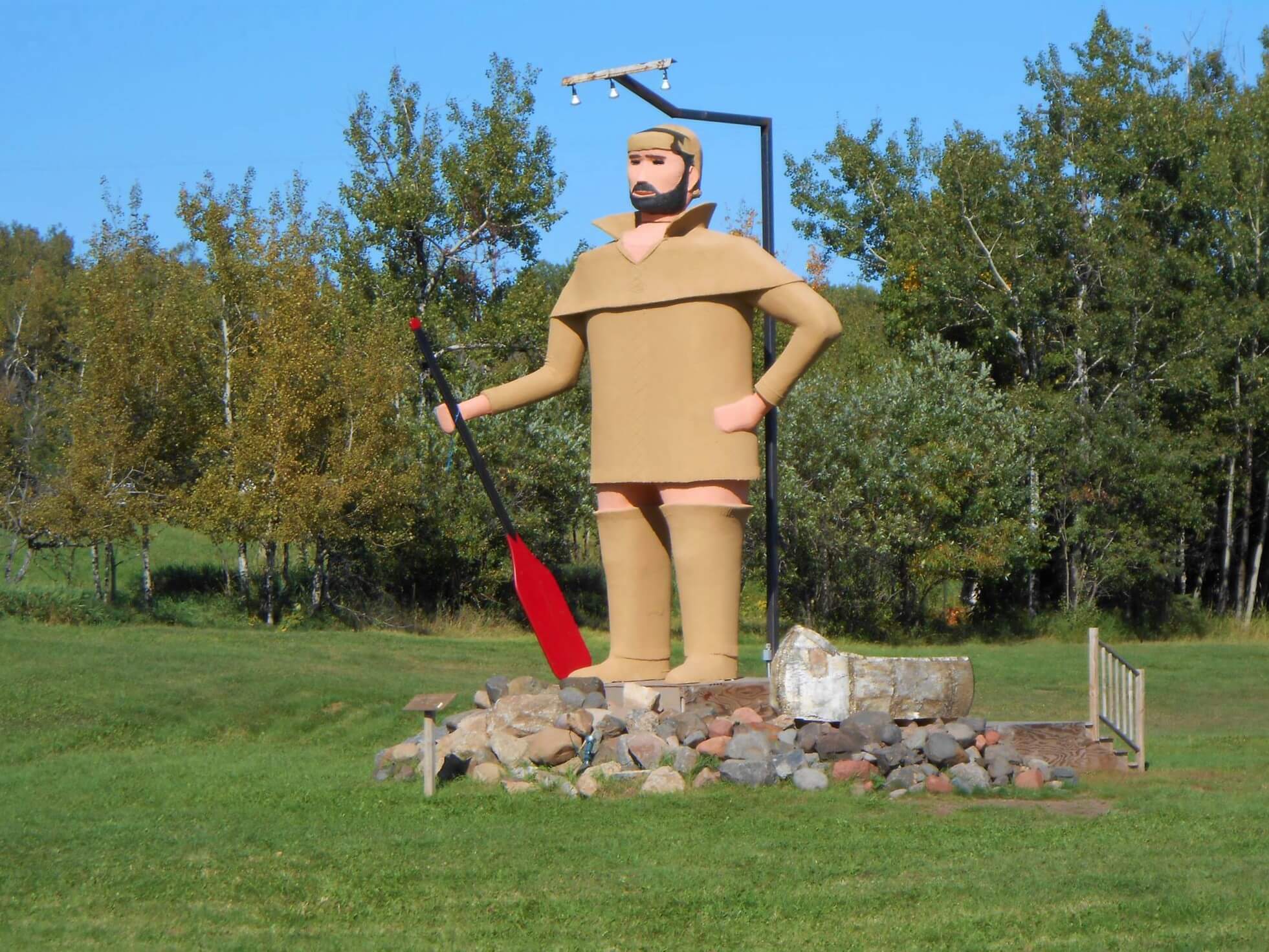
Pierre the Pantless Voyageur
Two Harbors
Pierre could be said to ride the fine line between folk art-adjacent roadside attraction and public art. (Is there even a line?) The 20-foot-tall fiberglass and mesh explorer has had an exciting life in the state’s northern reaches. In the ‘60s and ‘70s, Pierre had glowing red eyes and a speaker that allowed a motel employee to give delighted kids the scoop on the region’s history, per Exploring the North Shore.
Over the years, Pierre the Pantless Voyageur — a very unofficial name — spent time in front of Nelson’s Voyageur Museum and the nearby Voyageur Motel. When the museum closed, Pierre fell into disrepair. Then, when a fire destroyed the motel in 2008, Pierre almost went with it.
After years of neglect, the new owners sold Pierre to the Earthwood Inn just north of Two Harbors, where he’s been restored and on display ever since.
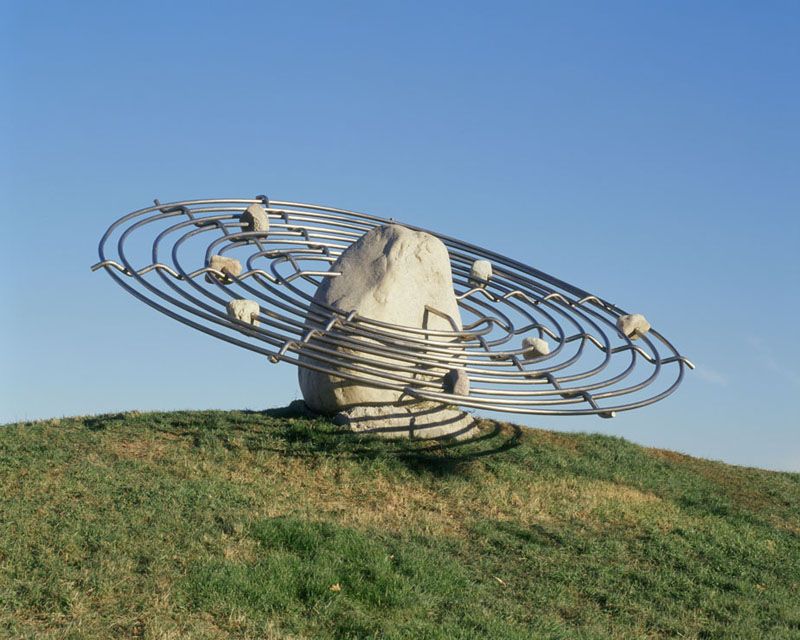
Saturn
Minneapolis
Sculptor Zoran Mojsilov, who has cited di Suvero as an influence, created this stop-you-in-your-tracks piece in Northeast Minneapolis. It’s a massive sculpture of Saturn with concentric rings and seven stones hooked into its orbit.
The park has multiple pieces by Mojsilov that all speak to each other in their use of huge stones and steel. Many of those stones were repurposed after being salvaged from a Minneapolis train yard. Surprisingly, you’ll also find a creation by the artist on hole 13 of the mini golf course at Can Can Wonderland in St. Paul.
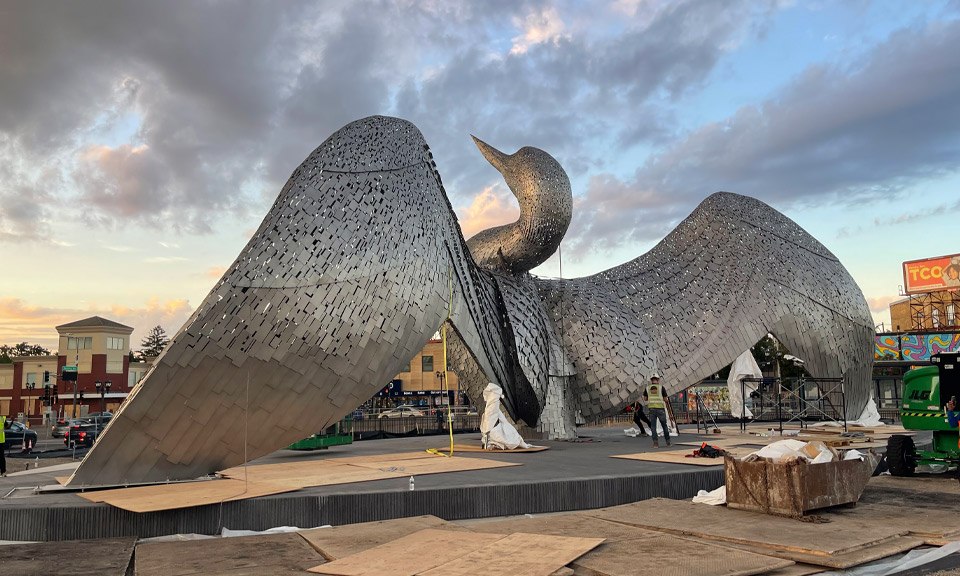
The Calling
St. Paul
“The Calling” is eye-catching and one of the newest landmarks in the Twin Cities. The three-story, 88-foot-wide loon sits outside Allianz Field, home of Minnesota United FC. The glittering monument to the state bird, installed in 2024, was created by Scottish artist Andy Scott. He told MPR that when asked to design an idea for the loon, he wasn’t familiar with the bird that isn’t native to Scotland but fell in love with the big, loud bird that is now a landmark in St. Paul’s Midway neighborhood.
Find more roadside attractions in Minnesota.
